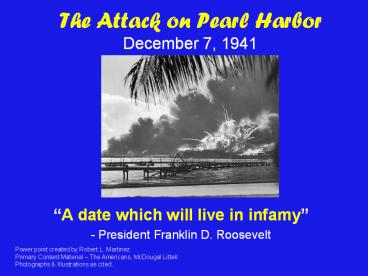The Attack on Pearl Harbor December 7, 1941 - PowerPoint PPT Presentation
Title:
The Attack on Pearl Harbor December 7, 1941
Description:
The Attack on Pearl Harbor December 7, 1941 A date which will live in infamy - President Franklin D. Roosevelt Power point created by Robert L. Martinez – PowerPoint PPT presentation
Number of Views:762
Avg rating:3.0/5.0
Title: The Attack on Pearl Harbor December 7, 1941
1
The Attack on Pearl HarborDecember 7, 1941
- A date which will live in infamy
- - President Franklin D. Roosevelt
Power point created by Robert L. Martinez Primary
Content Material The Americans, McDougal
Littell Photographs Illustrations as cited.
2
- Germanys European victories during WWII created
new opportunities for Japanese expansionists.
3
Japan was already in control of Manchuria.
4
Invasion of China 1937
- In July 1937, Hideki Tojo, chief of staff of
Japans Army, launched the invasion into China. - As French, Dutch, and British colonies lay
unprotected in Asia, Japanese leaders leaped at
the opportunity to unite East Asia under Japanese
control by seizing the colonial lands.
5
- As French, Dutch, and British colonies lay
unprotected in Asia, Japanese leaders leaped at
the opportunity to unite East Asia under Japanese
control by seizing the oil fields of colonial
lands.
6
- By 1941, the British were too busy fighting
Hitler to block Japanese expansion in the
Pacific. - Only the U.S. and its Pacific islands remained in
Japans way.
7
- The Japanese began their southward push in July
1941 by taking over French military bases in
Indochina (now Viet Nam, Cambodia, and Laos.) - The United States protested this act of
aggression by cutting off trade with Japan.
8
- The embargoed U.S. goods included one Japan could
not live without oil to fuel its war machine. - Japanese military leaders warned that without
oil, Japan could be defeated without its enemies
ever striking a blow.
9
- The military leaders declared that Japan must
either persuade the United States to end its oil
embargo or seize the oil fields in the Dutch East
Indies. - This would mean war.
10
- Shortly after becoming the prime minister of
Japan, Hideki Tojo met with Emperor Hirohito. - Tojo promised the emperor that the Japanese
government would attempt to preserve peace with
the Americans.
11
- Nevertheless, on November 5, 1941, Tojo ordered
the Japanese navy to prepare for an attack on the
United States.
12
- The U.S. military had broken Japans secret
communication codes and learned that Japan was
preparing for a strike. - What it didnt know was where the attack would
come.
13
- Late in November, Roosevelt sent out a war
warning to military commanders in Hawaii, Guam,
and the Philippines. - If war could not be avoided, the warning said,
the United States desires that Japan commit the
first overt act. And the nation waited.
14
Peace Talks
- The peace talks with the Japanese went on for a
month. Then on December 6, 1941, Roosevelt
received a decoded message that instructed
Japans peace envoy to reject all American peace
proposals. - This means war, an upset Roosevelt declared.
Japanese Flag
15
- Early the next morning, a Japanese dive-bomber
swooped low over Pearl Harbor the largest U.S.
naval base in the Pacific.
16
- This bomber was followed by more than 180
Japanese warplanes launched from six aircraft
carriers.
17
- As the first Japanese bombs found their targets,
a radio operator flashed this message - Air raid on Pearl Harbor. This is not a drill.
18
- For an hour and a half, the Japanese planes were
barely disturbed by U.S. anti-aircraft guns and
blasted target after target.
19
- By the time the last plane soared off around 930
A.M., the devastation had been massive.
20
American Casualties
- In less than two hours, the Japanese had killed
2,403 Americans and wounded 1,178 more.
21
- The surprise raid had sunk or damaged 21 ships,
including 8 battleships nearly the whole U.S.
Pacific fleet.
22
- More the 300 aircraft were severely damaged or
destroyed. - These loses constituted greater damage than the
U.S. Navy had suffered in all of World War I.
23
- By chance, three aircraft carriers at sea escaped
the disaster. - Their survival would prove crucial to the wars
outcome.
U.S.S. Yorktown
24
- The next day, President Roosevelt addressed
Congress. - Yesterday, December 7, 1941, a date which will
live in infamy, he said, the Japanese
launched an unprovoked and dastardly attack.
25
- Congress quickly approved Roosevelts request for
a declaration of war against Japan. - Three days later, Germany and Italy declared war
on the United States.
26
(No Transcript)
27
- For all the damage done at Pearl Harbor, perhaps
the greatest was to the cause of isolationism. - Many who had been former isolationists now
supported an all-out American effort.






























![get [PDF] DOWNLOAD Coast Guard Cutter Taney (Images of Ameri PowerPoint PPT Presentation](https://s3.amazonaws.com/images.powershow.com/10117902.th0.jpg?_=202409020511)
